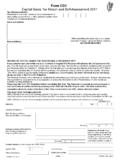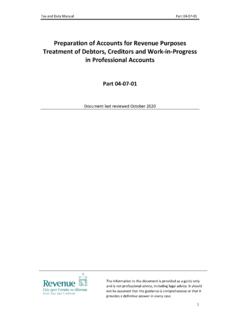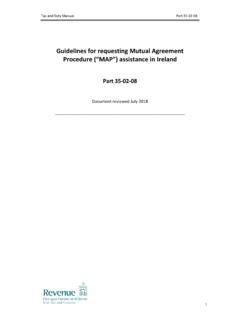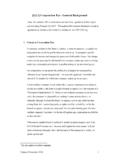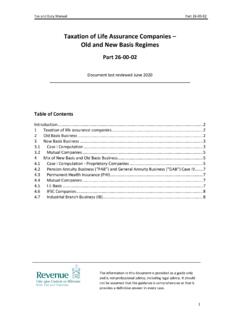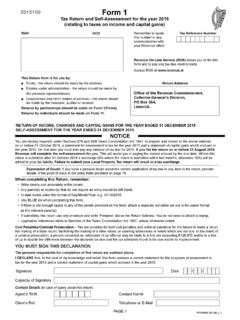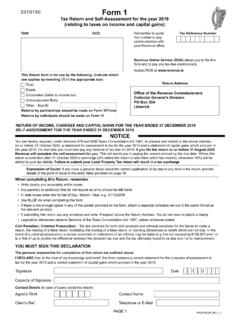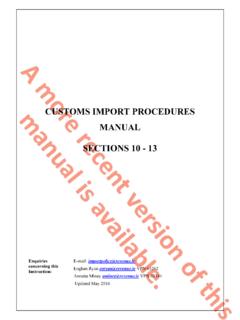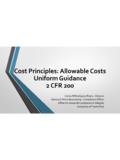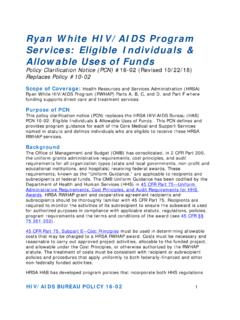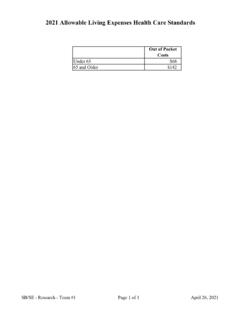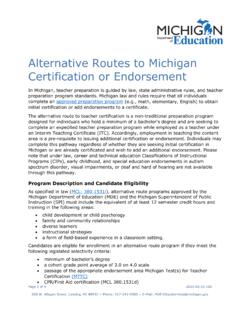Transcription of Acquisition, disposal and enhancement costs (S.552)
1 Tax and Duty Manual Part 19-02-10 The information in this document is provided as a guide only and is not professional advice, including legal advice. It should not be assumed that the guidance is comprehensive or that it provides a definitive answer in every , disposal and enhancement costs ( )Part 19-02-10 This document should be read in conjunction with section 552of the Taxes Consolidation Act 1997 Document last reviewed August 2021 Tax and Duty Manual Part 19-02-102 Table of and incidental and of arrangement reimbursed out of public and Value Added Tax ( VAT ).. and Capital Acquisitions Tax ( CAT ).. are deemed to have been sold and Share Option and Duty ManualPart 19-02-103 IntroductionSection 552 of the Taxes Consolidation Act 1997 ( TCA 1997 ) provides the basic rules for determining the expenditure to be allowed in computing chargeable gains.
2 allowable expenditure includes cost of acquisition of an asset, enhancement expenditure incurred during the period of ownership of the asset and costs incurred in disposing of the expenditureAllowable expenditure is divided into the following categories:(a) cost of acquisition, , the consideration which was given wholly and exclusively for the acquisition of the asset, plus the incidental costs of acquiring the asset; or, if the disposer created the asset ( , copyright or the goodwill of a business), the expenditure he or she incurred in creating it.(b)Additional expenditure, , expenditure incurred to add to the value of the asset, in so far as the expenditure is reflected in the state or nature of the asset at time of disposal ; and expenditure to establish or maintain legal title to the asset, or an interest in or right over it.(c)Incidental costs of disposal (restricted as in para ).
3 ExpenditureTo come within the first category of (b) of para , expenditure must not have proved futile or have wasted away before and Duty Manual Part 19-02-104 Example 1In 1995/96 X buys for 30,000 (including expenses) a plot of land (not being part of a garden within Section 604) and lays out on it a tennis court at a cost of 10,000. In 1999/00 X does away with the tennis court and builds in its place a swimming pool at a cost of 20, 2020 X sells the land for 300,000 (after deduction of expenses). The 10,000 which X spent on the tennis court is not allowable because it is not reflected in the state of the land on its computation is as follows:Sale price (net) 300,000 allowable expenditureCost of land 30, (indexation)= 38,310 cost of swimming pool 20, (indexation)= 23,860( 62,170)Chargeable gain 237,830(The demolition of a tennis court is not the "entire loss, destruction, dissipation or extinction of an asset" within section 538(1) TCA 1997 because it is not an "asset" being only part of an asset (the land); and it is not within section 538(3) TCA 1997 (see Tax and Duty Manual Part 19-01-09) because it is not a building or a structure in the nature of a building.)
4 CostsIt may be accepted that demolition costs are permanently reflected in the state of the land by the absence of the demolished building. In practice, the sole test of allowability is whether the purpose in incurring the expenditure was to enhance the value of the asset. Where, for example a building is erected in a garden and is subsequently removed and the garden reinstated, neither the cost of the building nor of its removal will normally be allowable . Where, however, the cost of demolition is small in relation to the cost of constructing a new building (as, for example, the cost of demolition of the tennis court in para ), no adjustment need be and dilapidation Expenditure incurred in repairing and putting into a fit state for letting a property acquired in a dilapidated condition is normally inadmissible as a deduction under Case V of Schedule D.
5 For Capital Gains Tax ( CGT ) purposes, however, such expenditure (including expenditure on decorations) may, in general, be regarded as allowable expenditure under section 552(1) TCA and Duty ManualPart incidental costsThe incidental costs of acquisition and disposal are defined in section 552(2) TCA 1997. The definition is exhaustive, , no other expenditure is "incidental costs " are limited to:(a)Fees, commission or remuneration paid for the professional services of any surveyor, valuer, auctioneer, accountant, agent or legal adviser so far as the expenditure is wholly and exclusively incurred for the purposes of the acquisition or disposal .(b)The costs of transfer or conveyance (including Stamp Duty) and the cost of advertising to find a seller or buyer.(c)The costs reasonably incurred in making any valuation or apportionment required for the purpose of computing the chargeable gain or allowable loss.
6 See, however, para regarding the costs of appeals on questions of market value.(d)The costs of legal and actuarial services including Stamp Duty on transfers and ancillary expenses incurred in varying or ending a settlement (see v Chubb's Trustee, 1971 47 353) or upon the termination of a life interest in possession. The allowable expenditure may include fees in respect of discharges, withdrawal fees and commission on transfer of assets to beneficiaries (but not insurance premiums) and, when necessary, should be apportioned between chargeable and non-chargeable assets by reference to the costs of transfer, etc., have been borne by the person to whom the property is transferred, he or she may either be allowed a deduction for these costs or he or she may forego a claim and permit the trustees to treat these costs as an allowable deduction in computing their chargeable gain arising from the deemed disposal .
7 (e)Any part of a liquidator's expenditure which has been wholly and exclusively incurred in disposing of a company's assets. A liquidator is normally a professional person an accountant, and in his or her capacity as liquidator may pay himself or herself fees for professional services. Insofar as it can be shown that such fees (or part thereof) have been wholly and exclusively incurred in disposing of a company s assets, such fees may be included in the part of the liquidator s expenditure ranking as an allowable deduction. Where the actual expenditure on specific assets cannot be identified, a reasonable apportionment may be and Duty Manual Part advisersFees paid to a professional adviser are allowable only to the extent that they are directly referable to the cost of acquiring or disposing of each particular investment. To the extent that the fees are referable to advice about the general state of markets or the prospects of particular forms of investment or the management of a portfolio, they are not in respect of subscriptions for periodicals or for publications by analysts, stockbrokers or other professional advisers, whether for public or private circulation, or other similar types of expenditure, are not ' fees are allowable only to the extent that they refer to the ascertainment of market value of the assets or to any apportionment for the purposes of the computation.
8 Otherwise, fees for the computation of liability are not allowable . It follows that, in the case of quoted securities, allowable accountancy fees will usually be very and companiesWhere a company finances building work out of borrowed money, and charges the interest on that money to capital, then, except in so far as such interest has been taken into account for the purposes of relief under the Income Tax ( IT ) Acts, or could have been so taken into account but for an insufficiency of income or profits or gains, the expenditure qualifying for allowance under section 552 TCA 1997 is to include any such interest in respect of the time up to the of appealsThe costs of appeals (or contributions thereto) on questions of market value should not be treated as allowable arrangement feesFees of building societies, solicitors and valuers and any other costs of arranging a mortgage or other loan in connection with the acquisition of an asset should not be treated as allowable premiumsPremiums paid under a policy of insurance against risk of damage to or depreciation of the asset are not allowable and Duty ManualPart reimbursed out of public moneyUnder section 565 TCA 1997, no allowance should be given for any expenditure otherwise allowable which is met by the State or by any government, by any board established by statute or by any public or local authority.
9 Whether in the State or TaxForeign tax on the disposal of an asset is allowable expenditure to the extent that the tax does not qualify for double taxation relief (see section 828 TCA 1997). and Value Added Tax ( VAT )Where a chargeable asset is acquired otherwise than as an asset of a trade, the cost for CGT purposes should be the cost inclusive of any VAT borne on the purchase. Where, however, the asset is acquired as an asset of a trade and the VAT borne on it is part of the trader's deductible "input tax , the cost , where relevant for capital gains purposes, should be the cost exclusive of and Capital Acquisitions Tax ( CAT )Neither Inheritance Tax nor Gift Tax (both components of CAT) is an allowable deduction in arriving at a chargeable gain. In an appeal before the Circuit Court in November 2008, the taxpayer s grounds of appeal were that Inheritance Tax was Part of the incidental costs of acquiring the asset, Expenditure wholly and exclusively incurred in establishing the person s title to the asset, costs incidental to the making of the decision upheld Revenue s long-standing view that CAT (Inheritance Tax)
10 Is not a deductible cost for same treatment should be given to Gift currencyThe cost of an asset acquired in a foreign currency is to be translated into the currency of the State, at the rate in place at the time of acquisition, for the purposes of the computation of CGT liability on its subsequent and Duty Manual Part are deemed to have been sold and reacquiredWhere, for the purpose of computing chargeable gains, assets are deemed to have been sold and immediately reacquired ( , where liability is based upon market value at 6 April 1974) no incidental notional expenditure, such as would have been incurred in actual transactions ( , transfer fees), should be Share Option SchemesFor CGT purposes, the allowable cost of shares that have been issued to an individual under an unapproved share option scheme has been, under current interpretation, the sum of the following:(a)The cost (if any) of the option [section 540(4) TCA 1997] see Note 1(b)The price paid for shares on exercise of the option [section 552(1) TCA 1997] see Note 2, and(c)The amount charged to IT on the exercise of the option (section 128 TCA 1997).
